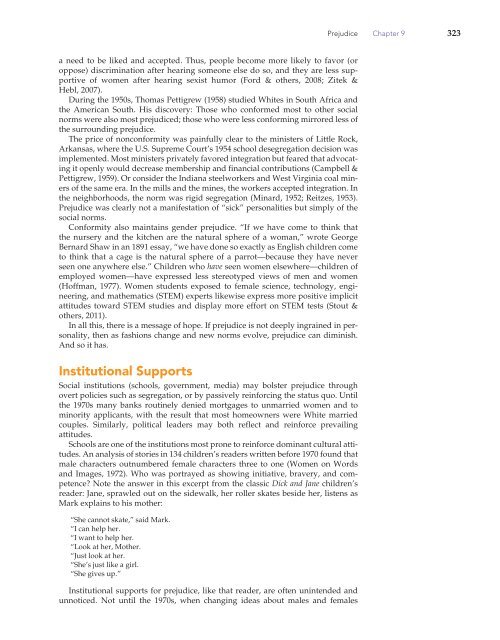Chapter 9: Prejudice: Disliking Others (2947.0K) - Bad Request
Chapter 9: Prejudice: Disliking Others (2947.0K) - Bad Request
Chapter 9: Prejudice: Disliking Others (2947.0K) - Bad Request
Create successful ePaper yourself
Turn your PDF publications into a flip-book with our unique Google optimized e-Paper software.
a need to be liked and accepted. Thus, people become more likely to favor (or<br />
oppose) discrimination after hearing someone else do so, and they are less supportive<br />
of women after hearing sexist humor (Ford & others, 2008; Zitek &<br />
Hebl, 2007).<br />
During the 1950s, Thomas Pettigrew (1958) studied Whites in South Africa and<br />
the American South. His discovery: Those who conformed most to other social<br />
norms were also most prejudiced; those who were less conforming mirrored less of<br />
the surrounding prejudice.<br />
The price of nonconformity was painfully clear to the ministers of Little Rock,<br />
Arkansas, where the U.S. Supreme Court’s 1954 school desegregation decision was<br />
implemented. Most ministers privately favored integration but feared that advocating<br />
it openly would decrease membership and financial contributions (Campbell &<br />
Pettigrew, 1959). Or consider the Indiana steelworkers and West Virginia coal miners<br />
of the same era. In the mills and the mines, the workers accepted integration. In<br />
the neighborhoods, the norm was rigid segregation (Minard, 1952; Reitzes, 1953).<br />
<strong>Prejudice</strong> was clearly not a manifestation of “sick” personalities but simply of the<br />
social norms.<br />
Conformity also maintains gender prejudice. “If we have come to think that<br />
the nursery and the kitchen are the natural sphere of a woman,” wrote George<br />
Bernard Shaw in an 1891 essay, “we have done so exactly as English children come<br />
to think that a cage is the natural sphere of a parrot—because they have never<br />
seen one anywhere else.” Children who have seen women elsewhere—children of<br />
employed women—have expressed less stereotyped views of men and women<br />
(Hoffman, 1977). Women students exposed to female science, technology, engineering,<br />
and mathematics (STEM) experts likewise express more positive implicit<br />
attitudes toward STEM studies and display more effort on STEM tests (Stout &<br />
others, 2011).<br />
In all this, there is a message of hope. If prejudice is not deeply ingrained in personality,<br />
then as fashions change and new norms evolve, prejudice can diminish.<br />
And so it has.<br />
Institutional Supports<br />
Social institutions (schools, government, media) may bolster prejudice through<br />
overt policies such as segregation, or by passively reinforcing the status quo. Until<br />
the 1970s many banks routinely denied mortgages to unmarried women and to<br />
minority applicants, with the result that most homeowners were White married<br />
couples. Similarly, political leaders may both reflect and reinforce prevailing<br />
attitudes.<br />
Schools are one of the institutions most prone to reinforce dominant cultural attitudes.<br />
An analysis of stories in 134 children’s readers written before 1970 found that<br />
male characters outnumbered female characters three to one (Women on Words<br />
and Images, 1972). Who was portrayed as showing initiative, bravery, and competence?<br />
Note the answer in this excerpt from the classic Dick and Jane children’s<br />
reader: Jane, sprawled out on the sidewalk, her roller skates beside her, listens as<br />
Mark explains to his mother:<br />
“She cannot skate,” said Mark.<br />
“I can help her.<br />
“I want to help her.<br />
“Look at her, Mother.<br />
“Just look at her.<br />
“She’s just like a girl.<br />
“She gives up.”<br />
Institutional supports for prejudice, like that reader, are often unintended and<br />
unnoticed. Not until the 1970s, when changing ideas about males and females<br />
<strong>Prejudice</strong> <strong>Chapter</strong> 9 323

















